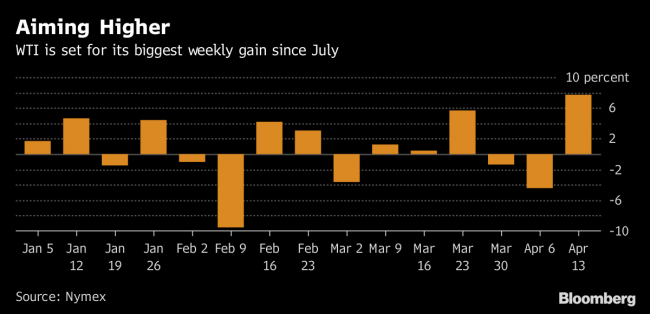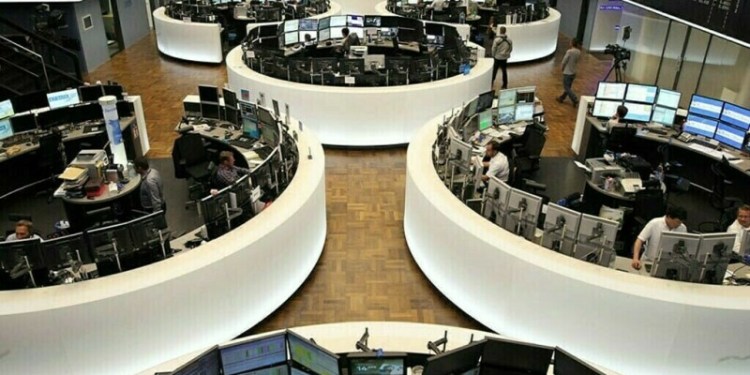
(Bloomberg) — The case for owning commodities has rarely been stronger, according to Goldman Sachs.
With raw materials rallying on escalating political tensions across the globe and economic growth remaining strong, the bank’s analysts including Jeffrey Currie doubled down on their “overweight” recommendation. They reiterated a view that commodities will yield returns of 10 percent over the next 12 months, according to an April 12 note.
The Bloomberg Commodity Index, a measure of returns from 22 raw materials, is up more than 2.5 percent this week, the most in two months. A similar gauge, the S&P GSCI Index, has rallied over 5 percent this week to levels last seen in 2014.
The gains are being driven by crude, which is set for its best weekly jump since July, and aluminum, poised for its strongest rally since 1987. Oil investors are rattled by the potential for Middle East supply disruptions in the wake of the U.S. threatening to bomb Russian ally Syria, Saudi Arabia shooting down missiles fired by rebels in Yemen, and rising concern that America would reimpose sanctions on Iran and curb its exports.
In the aluminum market, U.S. sanctions on Russian producer United Company Rusal (MCX:), the biggest maker of the metal outside China, have sent buyers scrambling to find supplies.
“With low cross-asset correlations, increasing inflationary risks, a positive carry and the potential for oil supply disruptions in the Middle East, the strategic case for owning commodities has rarely been stronger,” the Goldman analysts wrote in their report.
, the benchmark for more than half the world’s oil, has risen 7.2 percent this week to $71.96 by 6:56 a.m. in London on Friday. are up 7.9 percent on the week at $66.99 a barrel in New York as the escalating tensions have taken investor focus away from concern that an American crude boom will undermine OPEC’s output curbs to clear a global glut.
The missiles fired at Saudi Arabia by pro-Iranian Houthi rebels in Yemen and the prospect of U.S. retaliation against Syrian President Bashar al-Assad — whose forces are backed by both Russia and Iran — for a suspected chemical weapons attack raises the risk of supply disruptions, Goldman said.
“The unilateral nature in the escalation of tensions so far suggests that the production impacts would likely be modest initially unless a military conflict occurs between Saudi Arabia and Iran,” the bank’s analysts wrote. “With low and declining inventories the market remains vulnerable to even small disruptions.”
Sanctions Threat
There’s also increasing concern whether the U.S. will pull out of a deal between Iran and global powers that eased sanctions on the OPEC nation in exchange for curbs on its nuclear program. The appointment of John Bolton as National Security Advisor and Mike Pompeo as Secretary of State, both vocal Iran hawks, has significantly increased the odds of sanctions being reintroduced by President Donald Trump’s administration, Goldman said.
If that happens, European refiners may cut imports from Iran, given their exposure to the U.S., either through assets or product trade flows, according to the bank. “The EU accounts for 25 percent of Iran’s 2.6 million barrel-a-day crude exports but we believe the key for the global oil market is whether these flows will be curtailed rather than simply redirected to Asia,” the analysts wrote.
In the aluminum market, all parts of the supply chain are rushing to assess the risks of handling metal from Rusal, a company that Goldman said represents 6 percent of global output. The moves will drive significant disruption in the near term, according to the bank, which flagged upside risks to its end-year forecast of $1,950 a metric ton.
“We now expect to remain high and volatile through early June when markets will be forced to come to terms with the structure of the sanctions,” the Goldman analysts wrote.
Prices on the London Metal Exchange have jumped more than 12 percent this week to $2,296.50 a ton after surging to a six-year high on Thursday. Aluminum’s gains on the LME have outstripped increases in China in the past week, potentially making exports more profitable for the Asian nation’s traders just as their domestic market struggles with bloated stockpiles.
That dynamic, and a collapse in Rusal’s share value, will “incentivize a restructuring of Rusal’s assets and redirect global aluminum flows to establish a new equilibrium,” the Goldman Sachs (NYSE:) analysts said. “There is significant upside risk and potential volatility as markets find the new equilibrium.”
Source: Investing.com



























